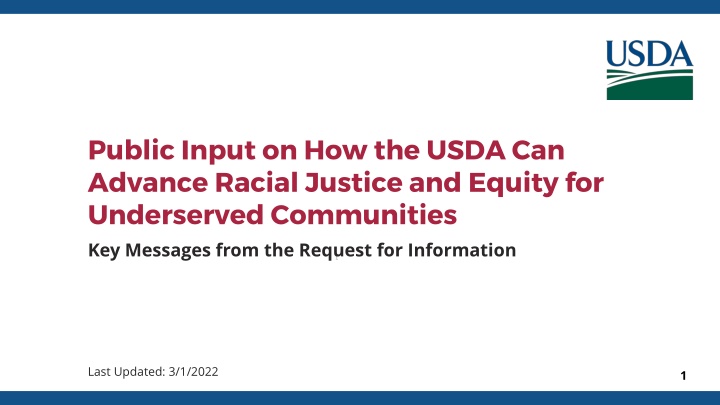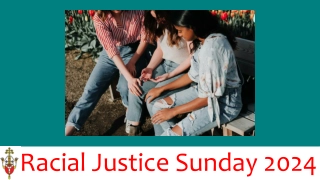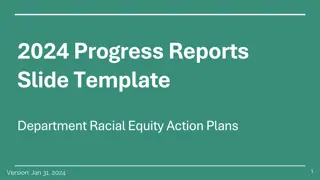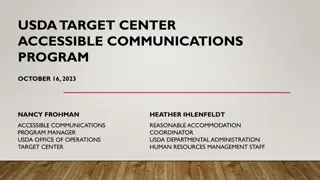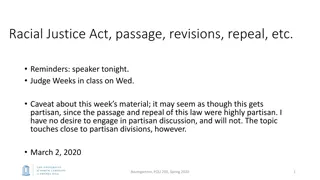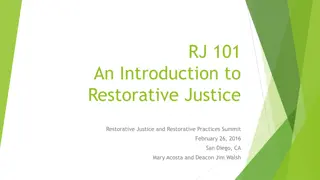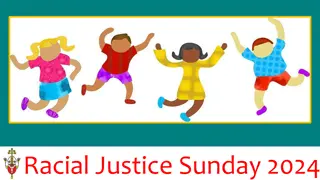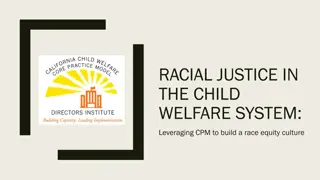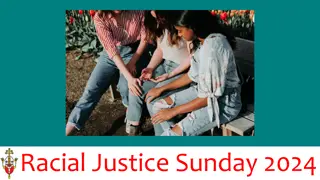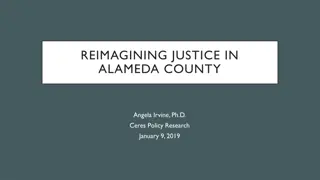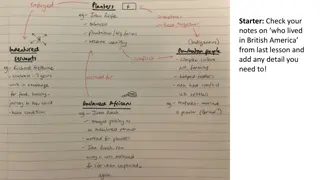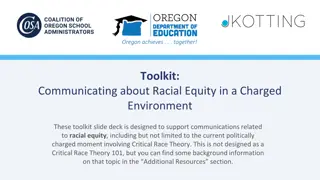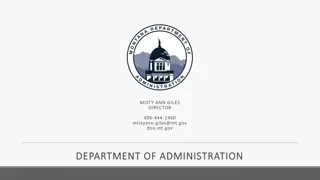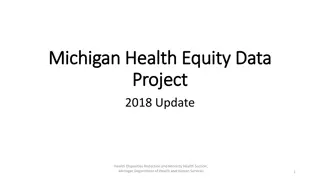USDA's Path to Racial Justice & Equity
The USDA sought public input on advancing racial justice and equity for underserved communities. Key themes included historical inequities, lack of representation, barriers to access programs, and more. Explore the results and themes that emerged from the public feedback.
Download Presentation

Please find below an Image/Link to download the presentation.
The content on the website is provided AS IS for your information and personal use only. It may not be sold, licensed, or shared on other websites without obtaining consent from the author.If you encounter any issues during the download, it is possible that the publisher has removed the file from their server.
You are allowed to download the files provided on this website for personal or commercial use, subject to the condition that they are used lawfully. All files are the property of their respective owners.
The content on the website is provided AS IS for your information and personal use only. It may not be sold, licensed, or shared on other websites without obtaining consent from the author.
E N D
Presentation Transcript
Public Input on How the USDA Can Advance Racial Justice and Equity for Underserved Communities Key Messages from the Request for Information 1 Last Updated: 3/1/2022 1
Background Guided by Executive Order 13985, Advancing Racial Equity and Support to Underserved Communities The Request for Information solicited information from the public two ways: Written comment through the Federal Register Public listening sessions The RFI included 10 targeted questions and respondents could submit up to 20 pages 2
Request for Information Written Comment Timeline June 16, 2021 August 14, 2021 July 15, 2021 Extended Deadline RFI Original Deadline Released 3
Results USDA received 537 total comments via the RFI federal register notice and ten listening sessions 426 written comments were submitted through the Federal Register 111 verbal comments were collected between July and September 2021 The respondents represented all regions of the U.S. and included farmers of color, state and Tribal governments, non-profits, food policy councils, and more All comments were recorded, transcribed, and aggregated 4
Themes Thematic analysis was used to analyze the comments. The key themes or topics that emerged are broken down into the following categories: General themes across USDA Staff Office and Mission Areas Food, Nutrition, and Consumer Service Themes Food Production and Conservation Themes Natural Resources and Environment Themes Rural Development Themes Civil Rights Themes Tribal Themes 5 5
Themes that Apply Across USDA Mission Areas (1/3) USDA has a history of discrimination and racial inequity Historical systemic and institutional racism affects current customers and employees Staff is not representative of populations served Many groups have alleged discrimination by the USDA County-level decision-making excludes BIPOC farmers and organizations Discrimination contributes to the racial wealth gap and land loss faced by Black and Indigenous producers The combination of these inequities, inability to secure desired programs and services, and history of discrimination have led to a lack of trust by underserved communities Barriers to accessing and participating in USDA programs Language barriers, and lack of translation services and bilingual staff Lack of land access, retention, and ownership by farmers of color Applications contain jargon, technical language, and can be difficult to navigate Application and reporting paperwork are burdensome Insufficient program outreach and technical assistance 6
Themes that Apply Across USDA Mission Areas (2/3) Barriers to accessing and participating in USDA programs Cont. Limited awareness by USDA staff of tribal government structures and needs Lack of internet access in rural areas and/or low computer literacy skills Limited access to capital and limited awareness of how to facilitate cost-sharing Opportunities for the USDA to become more equitable internally Diversify staff at all levels and hire more bilingual staff Implement mandatory DEIA staff training and resources, including cultural awareness trainings on Tribal communities Include participation of BIPOC stakeholders in decision-making Use inclusive language and imagery on websites and materials 7
Themes that Apply Across USDA Mission Areas (3/3) Other recommended policies and practices that apply across Mission Areas Provide translation services for all programs and services, and remove technical language and confusing acronyms Create pathways for farm workers, beginning farmers, and BIPOC farmers to own and operate farmland Ensure grant funds are distributed equitably and remove cost-sharing requirements Increase engagement, outreach, and 1:1 technical assistance to underserved communities; ensure offices are sufficiently staffed to provide these services Partner with trusted local organizations and land-grant universities to build capacity and support program outreach and delivery Create more equitable USDA foods procurement practices Increase funding opportunities specific to BIPOC farmers and organizations Increase recruitment, education, and job training for underserved communities by leveraging the Cooperative Extension System and workforce development partnerships Include more identity groups when capturing race and ethnicity data and disaggregate data to allow reporting to the local level 8
Discrimination has been a large contributor in the dramatic reduction of the number of farmers of color in the U.S. For Black farmers, they made up 14 percent of American farmers a century ago. Today they are only 1.4 percent. -National Farmers Union 9 9
This Executive Order is an important first step in rectifying the long history of racist discrimination by the USDA to Black farmers. Black farmers were systematically denied loans and other resources from the USDA, contributing to the massive loss of Black-owned farms in this country. In order to create an equitable footing for Black farmers to regain their agricultural opportunities, this discrimination must be addressed, and redressed. 10 -Andrea N. 10
Justice for Migrant Women supports increased training, monitoring, and enforcement of Title VI of the Civil Rights Act to ensure meaningful language access for individuals with limited English proficiency in all federally funded programs and across agencies, including those under the jurisdiction of USDA. -Justice for Migrant Women 11 11
Food, Nutrition, and Consumer Services Themes (1/2) Barriers to accessing and participating in FNCS programs Lack of reliable and convenient transportation to attend in-person WIC interviews and nutrition education events Customer service for food assistance programs can vary greatly and call center wait times can be too long Lifetime SNAP and TANF ban for those with a previous felony drug conviction Able Bodied Adults without Dependents (ABAWD) time limits and work requirements rule Enrollment paperwork is burdensome and redundant if applying to more than one program Stigma associated with food assistance programs Eligible tribal citizens are disallowed from participating in both SNAP and FDPIR at the same time Lack of culturally appropriate SNAP-Ed materials for minority communities Unpredictable income can result in reduced or lost benefits Recommended policies and practices to make FNCS more equitable Simplify applications and enrollment through automatic eligibility based on enrollment in other public assistance programs Improve customer service, call center wait times, and offer service and benefit delivery options via the phone, online, and in person 12
Food, Nutrition, and Consumer Services Themes (2/2) Recommended policies and practices to make FNCS more equitable Cont. Expand eligibility for food assistance programs including people with drug felony convictions and undocumented immigrants; expand the WIC program to include children up to six Allow Tribal governments to directly administer federal food assistance programs and participate in SNAP and FDPIR at the same time Expand online grocery and restaurant purchasing options Ensure federal nutrition programs use nutritious and culturally relevant food Honor cultural differences when creating meal pattern standards and nutrition education materials Increase SNAP benefit allotments Make universal school meals permanent or expand the Community Eligibility Provision Expand menu of WIC-approved foods to promote flexibility and improve culturally appropriate food options Remove the requirement for staff to identify and record peoples race or ethnicity if they decline to self-identify Co-locate and integrate SNAP and WIC services in health care and childcare settings 13
In addition to the inadequate amount of SNAP benefits, not everyone is able to easily access the benefits they are eligible to receive. The public charge rule created a chilling effect that scared families from applying to public benefit programs they were eligible for and resulted in one in seven adults in immigrant families avoiding participating in multiple public assistance programs in 2018 and 2019. -Kentucky Center for Economic Policy 14 14
The federal government should look for ways to align WIC eligibility with other federal programs like Medicaid and SNAP in order to combat declining enrollment and reduce certification requirements. Adjunctive eligibility between WIC and Medicaid streamlines the WIC application process, reduces administrative burdens, increases coordination between these complementary programs, and should be maintained. 15 -American Academy of Pediatrics 15
Ensure the Department looks for new ways to promote equity across underserved tribal communities. By providing households with healthy, high quality, and nutritious food we can eliminate this stress many families endure and pull them out of poverty faster. For American Indian and Alaska Natives, providing access and choice for traditional food choices is imperative. -Cherokee Nation 16 16
Food Production and Conservation Themes (1/3) Barriers to accessing and participating in FPAC programs Racial discrimination and bias by local USDA staff Deadlines during farming season are hard to meet Heir s property and fractionated land ownership issues contribute to land devaluation and loss Challenges getting to county USDA offices due to unpaved roads, distance, and lack of transportation, especially for tribal communities Exclusion of federal labor protections for farm workers such as workers compensation and lack of access to health insurance and disability insurance Lack of farmers of color on County Committees due to past experiences of discrimination and bias Opportunities to expand USDA accountability at all levels Respond to customers in a timely manner, especially regarding appeals and loans Be transparent when staff make administrative errors Require staff to provide customers a receipt for service and hold staff that do not comply accountable 17
Food Production and Conservation Themes (2/3) Opportunities to expand USDA accountability at all levels Cont. Provide rationale when loan or grant applications are denied and provide resources to help with future applications Increase transparency around complaints and make the filing process easier Recommended policies and practices to make FPAC more equitable Reduce loan processing times and create policies to ensure equitable and fair lending practices Provide equal access to program information to all farmers including women producers and migrant farm workers Improve access to markets and loans for BIPOC farmers Enhance support to Tribal communities by hiring more NRCS Tribal Liaisons and enhancing the Highly Fractionated Indian Land Loan Program Reform the County Committee structure to become more equitable, inclusive, and accountable Provide debt relief and financial support to BIPOC farmers 18
Food Production and Conservation Themes (3/3) Recommended policies and practices to make FPAC more equitable Cont. Support heir s property owners to protect family land and generational wealth Provide labor protections to migrant farm workers and address health risks such as heat stress Increase oversight of loan officers portfolios to identify and correct any racial discrimination Include urban farmers in the USDA farming census and provide technical support to these farmers 19
Farmers have extremely limited time and can't finish the applications. Some are confusing, detailed and require personal information that many farmers are not comfortable offering. Be more cognizant of time of the year. The seasons vary rapidly in the state. -Jamie N. 20 20
Farmers of color are often given the runaround when they go to USDA offices they are asked for more documentation than white farmers, they aren t provided with clear information, and they leave with the feeling that they are being pushed out. This has a deterrent effect. USDA should have staff dedicated to helping farmers navigate the application process, and go to the farmers, rather than making the farmers drive to the office multiple times. 21 -Barbara S. 21
It has been my experience that after reaching out to USDA staff via phone or email, I do not get any response, or I get an 8-week delayed response. Most of the time I do not feel like I am worthy of their focus or attention. As a result, I avoid engaging with staff and try to get knowledge and information on my own. 22 -Minority Farmer 22
Natural Resources and Environment Themes (1/2) Barriers to accessing and participating in NRE programs Lack of transportation or financial resources impedes access to National Trails and other public lands Limited understanding by Forest Service staff of the Federal Trust responsibilities to tribes Tribal and low-income communities experience disproportionality high levels of exposure, risk, and vulnerability to climate pollution and impacts The requirement for individuals to move for Forest Service jobs can inhibit those with strong social or cultural ties to communities from applying Opportunities to support and expand hiring for underserved communities Recruit employees at Historically Black Colleges and Universities and Tribal Universities Ensure participants in youth employment programs have productive, supportive, and psychologically and physically safe work environments Increase funding for youth access programs to enhance urban youth visitorship Hire individuals that are training and have knowledge of traditional and indigenous customers and cultures, and the varying needs of local climate vulnerable communities Expand direct-hire authorities to foster streamlined youth employment 23
Natural Resources and Environment Themes (2/2) Recommended policies and practices to make NRE more equitable Work to make public lands welcoming and accessible to all by partnering with community-based organizations, enhancing transportation options, and providing educational programs for urban communities Foster trust and accountability by improving tribal consultation, hosting bi-directional dialogues, and following up with meeting participants Integrate data about environmental justice communities and consider these communities needs Train Forest Service staff on the Federal Trust responsibilities to tribes Ensure information available on trails, trail maps and online resources is readily accessible, clearly understandable and consistent for novice and experienced trail users The Forest Service should expand co-management with sovereign native nations Provide educational, technical, and financial assistance to learn how to generate inform from forests, with a focus in underserved communities 24
Information should be available in multiple languages and provide complementary graphics. One idea would be to hire members of different communities and other diverse stakeholders to use currently available resources to plan a visit to a trail. Following their visits, they could report on their experiences in accessing information and spending time on the trail and advise on how to improve informational resources." -Partnerships for the National Trails System 25 25
Turnover of Forest Service staff makes it difficult to maintain trust and relationships with the Agency and results in a loss of institutional knowledge. One result of this is a lack of consistency in how the FS supports and addresses its Trust Responsibilities to tribes. -Anonymous 26 26
Rural Development Themes (1/2) Barriers to accessing and participating in RD programs Lack of program outreach, marketing, and technical assistance to farm and meatpacking workers, and Tribal Nations Immigrant status and visa requirements for Farm Labor Housing programs Many rural communities do not have grant writers, tools, or expertise to confidently apply for funds Limited infrastructure to support producers in getting food to market, such as storage and distribution infrastructure Lack of technical assistance to help people of color access housing loans in rural communities Limited, unreliable, and expensive access to internet 27
Rural Development Themes (2/2) Recommended policies and practices to make RD more equitable Support access to broadband and affordable internet services Ensure USDA offices are sufficiently staffed in rural areas to deliver great customer service, outreach, and technical assistance Build back trust with tribes and farm workers by visiting communities on a continuous basis and incorporating their needs into services and programs Work to maintain affordability of housing to reduce rural displacement Provide funding to enhance supply chain infrastructure to create more market opportunities Support rural economic development and recovery from COVID-19, and increase investment in small locally owned businesses 28
For many BIPOC farmers, moving to predominately white rural areas raises concerns about social isolation, acceptance and safety. -The Northeast Organic Farming Association Interstate Council 29 29
The Rural Energy for America Program provides loans and grants to agricultural producers and rural small businesses for renewable energy systems or to make energy efficiency improvements. The program is historically oversubscribed. Increased funding and additional flexibility in eligible recipients of the Rural Energy Program would create jobs and expand clean energy in rural communities. 30 -The Nature Conservancy 30
Civil Rights Themes (1/1) USDA Civil Rights Issues History of the USDA facing accusations of discrimination against women and people of color; complaints come from employees and customer program participants Concerns on how OASCR handles discrimination complaints which has resulted in lost complaints, very long processing times, and/or unfair outcomes Civil rights complaint process is cumbersome, confusing, and lacks transparency Some USDA employees feel discouraged to file a complaint and/or fear retaliation Opportunities to reform the Office of the Assistant Secretary of Civil Rights (OASCR) Prioritize and address civil rights complaints quickly and be transparent about the process Protect USDA employees that file civil rights complaints from retaliation Establish and maintain clear division between the Office of General Council (OGC) and OASCR for civil rights complaints by restricting access to information between the agencies and limiting communication Create an efficient and effective independent oversight function that conducts audits to reveal and correct discrimination and bias Update and implement workplace policies to prevent and address domestic violence, sexual assault, and sexual harassment among farmworker women and girls 31
Progress on equity cannot be achieved without investment in transparency, accountability, and integrity in all OASCR operations and activities. This commitment must be shared across leadership and permeate decision making at every level, from the establishing of policy to the processing of individual program and employment complaints. -SDFR Policy Research Center at Alcorn State University & the Food Law and Policy Clinic at Harvard Law School 32 32
USDAs civil rights programs are severely flaws. Civil rights is only allowed when someone has been harmed in a set definition. Bad conduct is often overlooked. -Anonymous 33 33
Tribal Themes (1/2) Opportunities to enhance engagement with Tribal Nations Acknowledge Tribal Nations sovereignty through strengthening the Nation-to-Nation relationship Regularly engage with Tribal Nations through the consultation process Meaningfully integrate Tribal management decisions at all levels of government and planning processes Provide staff training and education on tribal cultures, needs, and challenges Expand existing co-management authorities such as self-governance compacts and self- determination contracts Support and protect Tribal food sovereignty Opportunities to support for Tribal Nations Increase funding opportunities to support Tribal ownership, protection, and conservation of land Support market opportunities for tribes through research, funding, programs, and capacity building 34
Tribal Themes (2/2) Opportunities to support for Tribal Nations Cont. Enhance educational opportunities for Tribal youth by increasing the funding and staffing for the Federally-Recognized Tribes Extension Program (FRTEP) and other youth programs Support the development of Tribal research by making research programs and funding more accessible to Tribal colleges and universities Improve the adequacy and accuracy representation of Tribal Nations in National Agricultural Statistics Service data and conduct research to better understand tribal needs 35
The legacy of colonization and conquest has left deep wounds and harms on Indigenous communities, and food plays a significant part in this history. -MAZON: A Jewish Response to Hunger 36 36
The best way to uphold the trust relationship and responsibility is by institutionalizing the mechanisms to support Tribally driven solutions at the Department level, and implementing them in a manner consistent with the intent of Tribal leaders and Tribal producers. -Native Farm Bill Coalition 37 37
Thank you 38 38
